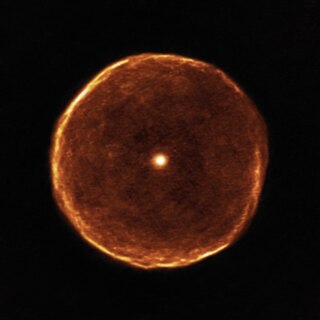U Antliae
| Stern U Antliae | |||||||||||||||||
|---|---|---|---|---|---|---|---|---|---|---|---|---|---|---|---|---|---|
(c) ALMA, CC BY 4.0 | |||||||||||||||||
| Aufnahme der Atacama Large Millimeter/submillimeter Array von einer Staubschale um U Antliae | |||||||||||||||||
| AladinLite | |||||||||||||||||
| Beobachtungsdaten Äquinoktium: J2000.0, Epoche: J2000.0 | |||||||||||||||||
| Sternbild | Luftpumpe | ||||||||||||||||
| Rektaszension | 10h 35m 12,85s [1] | ||||||||||||||||
| Deklination | −39° 33′ 45,3″ [1] | ||||||||||||||||
| Helligkeiten | |||||||||||||||||
| Scheinbare Helligkeit | 5.38 (5.27 bis 6.04) mag [1][2] | ||||||||||||||||
| Spektrum und Indices | |||||||||||||||||
| Veränderlicher Sterntyp | LB[2] | ||||||||||||||||
| B−V-Farbindex | (2.84) [1] | ||||||||||||||||
| U−B-Farbindex | (7.10) [1] | ||||||||||||||||
| R−I-Index | (1.32) [1] | ||||||||||||||||
| Spektralklasse | C-N5 C2 5 [2] | ||||||||||||||||
| Astrometrie | |||||||||||||||||
| Radialgeschwindigkeit | (41.0 ± 4.4) km/s [1] | ||||||||||||||||
| Parallaxe | (3.57 ± 0.20) mas [1] | ||||||||||||||||
| Entfernung | (910 ± 60) Lj (280) pc | ||||||||||||||||
| Visuelle Absolute Helligkeit Mvis | (−5.22) mag [3] | ||||||||||||||||
| Eigenbewegung [1] | |||||||||||||||||
| Rek.-Anteil: | (−31.37 ± 0.23) mas/a | ||||||||||||||||
| Dekl.-Anteil: | (2.37 ± 0.27) mas/a | ||||||||||||||||
| Physikalische Eigenschaften | |||||||||||||||||
| Masse | 1.04 M☉ | ||||||||||||||||
| Radius | 325 R☉ [4] | ||||||||||||||||
| Leuchtkraft | |||||||||||||||||
| Effektive Temperatur | 2800 K [5] | ||||||||||||||||
| Andere Bezeichnungen und Katalogeinträge | |||||||||||||||||
| |||||||||||||||||
U Antliae (U Ant) ist ein veränderlicher Stern im Sternbild Luftpumpe.[6]
U Antliae ist ein roter C-type Kohlenstoffstern und ein langsam unregelmäßig veränderlicher Stern mit einer Magnitude zwischen 5,27 und 6.04. Er hat eine Oberflächentemperatur von 2.800 K und befindet sich in einer Entfernung von etwa 900 Lichtjahren. Er scheint etwa mit der 8.000fachen Leuchtkraft der Sonne. Er ist von zwei Staubschalen umgeben, die er vor 14.000 und 10.000 Jahren abgestoßen hatte.
Siehe auch
Literatur
- Tilmann Althaus: Sternentwicklung: Sterbender Stern in der Blase. 20. September 2017 (spektrum.de).
Weblinks
- U Antliae: Ein sterbender Stern in atemberaubender Bildschärfe. In: Der Standard. derstandard.de, 24. September 2017, abgerufen am 23. Oktober 2017.
- Darstellung der Materiebewegungen in der Schale um U Antliae. eso.org, abgerufen am 23. Oktober 2017.
- ESO: Alternder Stern bläst Materie von sich + Karte, Fotos & Animationen vom 20. September 2017
- ALMA: Die Rauchblase von U Antliae. astronews.com, 20. September 2017, abgerufen am 23. Oktober 2017.
Einzelnachweise
- ↑ a b c d e f g h U Ant. In: SIMBAD. Centre de Données astronomiques de Strasbourg, abgerufen am 8. September 2018.
- ↑ a b c U Ant. In: VSX. AAVSO, abgerufen am 8. September 2018.
- ↑ Guandalini, R., Cristallo, S.: Luminosities of carbon-rich asymptotic giant branch stars in the Milky Way. In: Astronomy & Astrophysics. 555. Jahrgang, 2013, A120, S. 7, doi:10.1051/0004-6361/201321225, arxiv:1305.4203, bibcode:2013A&A...555A.120G.
- ↑ E. De Beck, L. Decin, A. De Koter, K. Justtanont, T. Verhoelst, F. Kemper, K. M. Menten: Probing the mass-loss history of AGB and red supergiant stars from CO rotational line profiles. II. CO line survey of evolved stars: Derivation of mass-loss rate formulae. In: Astronomy and Astrophysics. 523. Jahrgang, 2010, S. A18, doi:10.1051/0004-6361/200913771, arxiv:1008.1083, bibcode:2010A&A...523A..18D.
- ↑ a b F. Kerschbaum, D. Ladjal, R. Ottensamer, M. A. T. Groenewegen, M. Mecina, J. A. D. L. Blommaert, B. Baumann, L. Decin, B. Vandenbussche, C. Waelkens, T. Posch, E. Huygen, W. De Meester, S. Regibo, P. Royer, K. Exter, C. Jean: The detached dust shells of AQ Andromedae, U Antliae, and TT Cygni. In: Astronomy & Astrophysics. 518. Jahrgang, 2010, S. L140, doi:10.1051/0004-6361/201014633, arxiv:1005.2689, bibcode:2010A&A...518L.140K.
- ↑ Der Stern U Antliae im Sternbild Luftpumpe (lat. Antlia). eso.org, abgerufen am 23. Oktober 2017.
Auf dieser Seite verwendete Medien
Opaque red circle
Autor/Urheber: IAU and Sky & Telescope magazine (Roger Sinnott & Rick Fienberg), Lizenz: CC BY 3.0
IAU Antlia chart
(c) ALMA, CC BY 4.0
Delicate bubble of expelled material around the cool red star U Antliae
This ALMA image reveals much finer structure in the U Antliae shell than has previously been possible. Around 2700 years ago, U Antliae went through a short period of rapid mass loss. During this period of only a few hundred years, the material making up the shell seen in the new ALMA data was ejected at high speed. Examination of this shell in further detail also shows some evidence of thin, wispy clouds known as filamentary substructures.
Coordinates Position (RA): 10 35 12.87 Position (Dec): -39° 33' 44.99" Field of view: 2.18 x 2.18 arcminutes Orientation: North is 0.5° right of vertical
Colours & filters Band Wavelength Telescope Millimeter 230 GHz 1.3 mm Atacama Large Millimeter/submillimeter Array Band 6.




